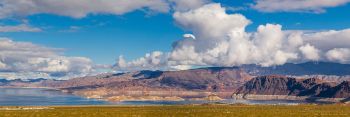Reservoirs: Difference between revisions
From ASDSO Dam Safety Toolbox
Rmanwaring (talk | contribs) (Created page with "__NOTOC__ ---- <!-- Delete any sections that are not necessary to your topic. Add pictures/sections as needed --> Reservoirs are artificial bodies of water impounded behind a dam for one or more intended purposes including water storage, flood protection, hydropower generation, or recreation. ==Components of a Reservoir== [Paragraph here] ==Life Cycle of a Reservoir== [Paragraph here] #Design and Construction of a Reservoir #O&M of a Reservoir #Decommission...") |
No edit summary |
||
| Line 2: | Line 2: | ||
---- | ---- | ||
<!-- Delete any sections that are not necessary to your topic. Add pictures/sections as needed --> | <!-- Delete any sections that are not necessary to your topic. Add pictures/sections as needed --> | ||
{{Picture | |||
|image= | |||
<!-- Add image file name (ex.image.jpg) --> | |||
reservoir-mead.jpg | |||
|link= | |||
<!--https://www.nps.gov/lake/planyourvisit/lake-mead.htm--> | |||
|caption= | |||
<!-- Add picture caption --> | |||
Lade Mead, a reservoir formed by the Hoover Dam and Colorado River, is the largest reservoir in the United States by water capacity. (National Parks Service) | |||
}} | |||
Reservoirs are artificial bodies of water impounded behind a dam for one or more intended purposes including water storage, flood protection, hydropower generation, or recreation. | Reservoirs are artificial bodies of water impounded behind a dam for one or more intended purposes including water storage, flood protection, hydropower generation, or recreation. | ||
Revision as of 20:15, 9 September 2022

|
| Lade Mead, a reservoir formed by the Hoover Dam and Colorado River, is the largest reservoir in the United States by water capacity. (National Parks Service) |
Reservoirs are artificial bodies of water impounded behind a dam for one or more intended purposes including water storage, flood protection, hydropower generation, or recreation.
Components of a Reservoir
[Paragraph here]
Life Cycle of a Reservoir
[Paragraph here]
Examples
![]()
Best Practices Resources
![]()
Trainings
![]()
Citations:
Revision ID: 2689
Revision Date: 09/09/2022
